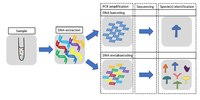
Photo from wikipedia
Deciphering the effect of neutral and deterministic processes on community assembly is critical to understand and predict diversity patterns. The information held in community trait distributions is commonly assumed as… Click to show full abstract
Deciphering the effect of neutral and deterministic processes on community assembly is critical to understand and predict diversity patterns. The information held in community trait distributions is commonly assumed as a signature of these processes, but empirical and modelling attempts have most often failed to untangle their confounding, sometimes opposing, impacts. Here, we simulated the assembly of trait distributions through stochastic (dispersal limitation) and/or deterministic scenarios (environmental filtering and niche differentiation). We characterized the shape of trait distributions using the skewness-kurtosis relationship. We identified commonalities in the co-variation between the skewness and the kurtosis of trait distributions with a unique signature for each simulated assembly scenario. Our findings were robust to variation in the composition of regional species pools, dispersal limitation and environmental conditions. While ecological communities can exhibit a high degree of idiosyncrasy, identification of commonalities across multiple communities can help to unveil ecological assembly rules in real-world ecosystems.
Journal Title: Ecology letters
Year Published: 2021
Link to full text (if available)
Share on Social Media: Sign Up to like & get
recommendations!